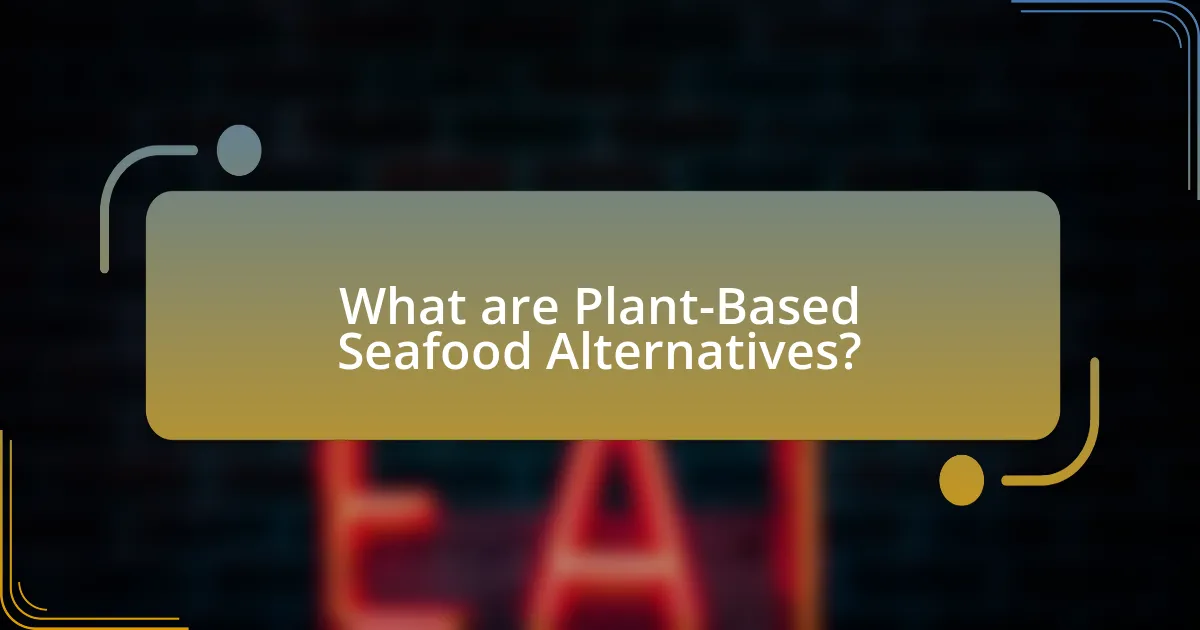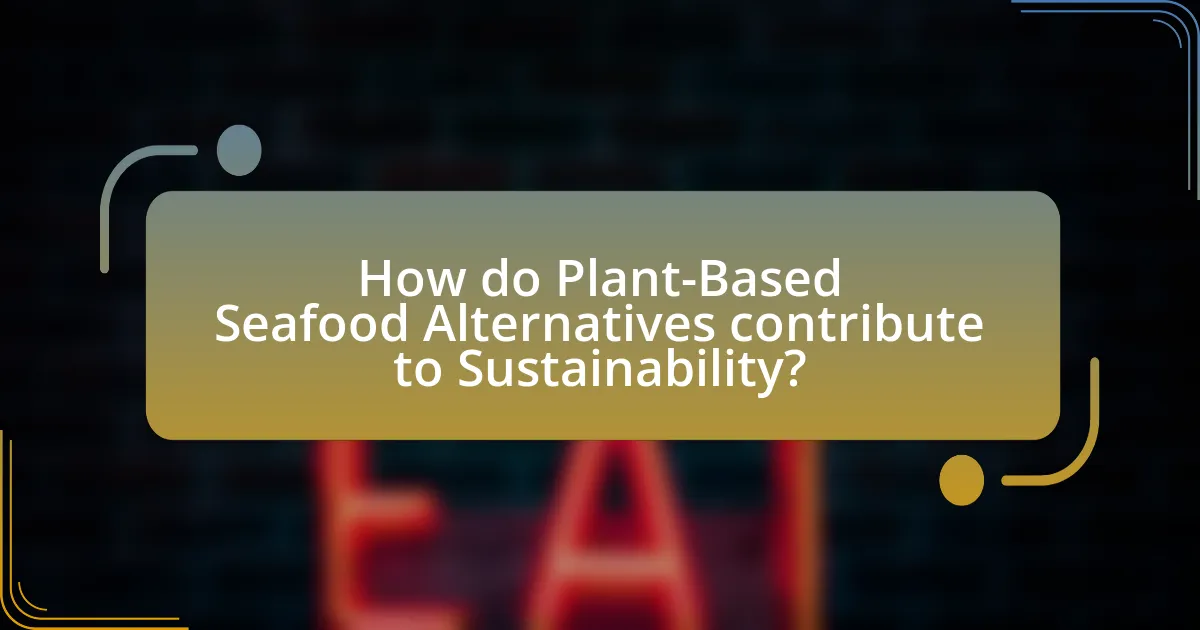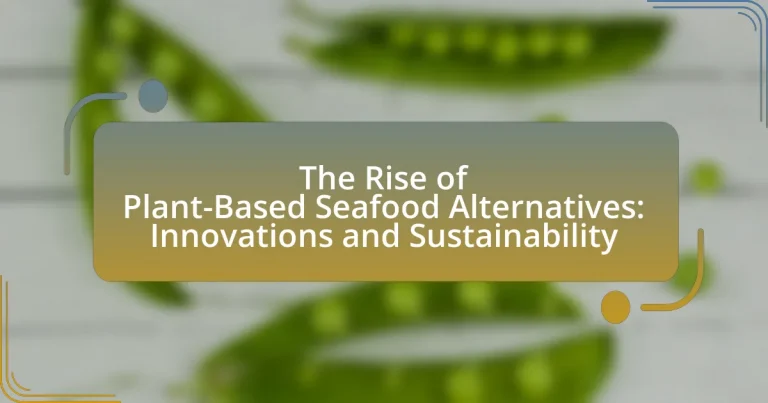Plant-based seafood alternatives are food products designed to replicate the taste, texture, and nutritional profile of traditional seafood using plant-derived ingredients such as algae, soy, and pea protein. The article explores the differences between these alternatives and conventional seafood, highlighting their environmental benefits, including reduced carbon emissions and lower resource usage. It discusses the growing consumer demand for sustainable food options, the health benefits of plant-based seafood, and the innovations driving this industry, such as advancements in food technology and 3D printing. Additionally, it examines how these alternatives contribute to sustainability by mitigating overfishing and ocean degradation, while also providing guidance for consumers on incorporating these products into their diets.

What are Plant-Based Seafood Alternatives?
Plant-based seafood alternatives are food products designed to mimic the taste, texture, and nutritional profile of traditional seafood, using ingredients derived from plants. These alternatives often utilize sources such as algae, soy, pea protein, and other plant-based ingredients to create products like fish fillets, shrimp, and crab cakes. The rise of these alternatives is driven by increasing consumer demand for sustainable and ethical food options, as traditional seafood harvesting poses significant environmental challenges, including overfishing and habitat destruction. According to a report by the Good Food Institute, the plant-based seafood market is projected to grow significantly, reflecting a shift towards more sustainable dietary choices.
How do Plant-Based Seafood Alternatives differ from traditional seafood?
Plant-based seafood alternatives differ from traditional seafood primarily in their ingredients and production methods. Traditional seafood is derived from marine animals, while plant-based alternatives are made from ingredients such as algae, soy, pea protein, and other plant sources. These alternatives aim to replicate the taste, texture, and nutritional profile of seafood without the environmental impact associated with fishing, such as overfishing and habitat destruction. For instance, a study published in the journal “Frontiers in Nutrition” highlights that plant-based seafood can significantly reduce carbon emissions and water usage compared to conventional seafood production.
What ingredients are commonly used in Plant-Based Seafood Alternatives?
Common ingredients used in plant-based seafood alternatives include pea protein, seaweed, konjac, and various starches. Pea protein serves as a primary protein source, while seaweed provides a seafood-like flavor and texture. Konjac, derived from the konjac plant, is often used for its gelatinous properties, mimicking the texture of certain seafood. Starches, such as potato or tapioca starch, are utilized to enhance the binding and texture of these products. These ingredients collectively contribute to the nutritional profile and sensory experience of plant-based seafood alternatives, aligning with consumer demand for sustainable and innovative food options.
How do these ingredients mimic the taste and texture of seafood?
Ingredients such as seaweed, konjac, and various plant proteins mimic the taste and texture of seafood by replicating the umami flavor profile and fibrous structure found in marine life. Seaweed provides a briny, ocean-like flavor, while konjac, with its gelatinous texture, can simulate the mouthfeel of fish. Additionally, plant proteins are often engineered to achieve a flaky texture similar to that of seafood, enhancing the overall sensory experience. Research indicates that these ingredients can effectively recreate the taste and texture of seafood, making them appealing alternatives for consumers seeking plant-based options.
Why is there a growing demand for Plant-Based Seafood Alternatives?
The growing demand for plant-based seafood alternatives is primarily driven by increasing consumer awareness of health, environmental sustainability, and ethical concerns regarding traditional seafood sourcing. Research indicates that 70% of consumers are seeking more plant-based options due to health benefits, such as lower cholesterol and higher fiber content. Additionally, the fishing industry faces significant challenges, including overfishing and habitat destruction, prompting consumers to seek sustainable alternatives. A report by the Good Food Institute highlights that the plant-based seafood market is projected to reach $1.3 billion by 2025, reflecting a shift towards environmentally friendly food choices.
What health benefits do Plant-Based Seafood Alternatives offer?
Plant-based seafood alternatives offer several health benefits, including lower levels of saturated fat and cholesterol compared to traditional seafood. These alternatives are often rich in essential nutrients such as omega-3 fatty acids, which can be derived from algae, providing heart health benefits. Additionally, they typically contain higher fiber content, promoting digestive health. Research indicates that diets high in plant-based foods can reduce the risk of chronic diseases, such as heart disease and diabetes, supporting overall health and wellness.
How do environmental concerns drive the popularity of Plant-Based Seafood Alternatives?
Environmental concerns significantly drive the popularity of plant-based seafood alternatives by highlighting the need for sustainable food sources. Overfishing and marine habitat destruction have led to alarming declines in fish populations, prompting consumers to seek eco-friendly options. According to a report by the Food and Agriculture Organization, nearly one-third of global fish stocks are overfished, which raises awareness about the environmental impact of traditional seafood consumption. As a result, plant-based seafood alternatives offer a solution that reduces pressure on marine ecosystems while providing similar nutritional benefits. This shift is further supported by consumer trends indicating a growing preference for sustainable products, with a survey from the Plant Based Foods Association revealing that 70% of consumers are more likely to purchase products that are environmentally friendly.

What Innovations are Shaping the Plant-Based Seafood Industry?
Innovations shaping the plant-based seafood industry include advancements in ingredient technology, flavor enhancement, and production methods. Companies are utilizing algae, pea protein, and other plant-based ingredients to replicate the texture and taste of traditional seafood. For instance, brands like Good Catch and Ocean Hugger Foods have developed products that mimic tuna and crab using a blend of legumes and seaweed, achieving a similar mouthfeel and flavor profile. Additionally, fermentation technology is being employed to enhance the umami flavor in plant-based seafood, making it more appealing to consumers. These innovations are supported by a growing consumer demand for sustainable and ethical food options, as evidenced by a report from the Plant Based Foods Association, which indicates that plant-based seafood sales have increased significantly in recent years, reflecting a shift towards more sustainable eating habits.
How are food technology advancements influencing Plant-Based Seafood Alternatives?
Food technology advancements are significantly enhancing the development and appeal of plant-based seafood alternatives. Innovations such as improved texturization techniques, flavor enhancement through fermentation, and the use of novel ingredients like algae and legumes are creating products that closely mimic the taste and texture of traditional seafood. For instance, companies like Good Catch Foods utilize a blend of legumes and seaweed to replicate the flavor profile of fish, which has been well-received in the market. Additionally, advancements in 3D printing technology allow for the precise replication of seafood shapes and textures, further increasing consumer acceptance. These technological improvements not only enhance sensory attributes but also contribute to sustainability by reducing reliance on overfished marine resources, aligning with consumer demand for environmentally friendly food options.
What role do fermentation and biotechnology play in creating these products?
Fermentation and biotechnology are crucial in creating plant-based seafood alternatives by enhancing flavor, texture, and nutritional profile. Fermentation processes utilize microorganisms to break down plant materials, resulting in umami flavors that mimic traditional seafood. For instance, specific strains of yeast and bacteria can produce compounds similar to those found in fish, improving taste and aroma. Biotechnology further enables the development of novel proteins and ingredients through genetic engineering, allowing for the creation of more sustainable and nutritious alternatives. Research has shown that these methods can significantly reduce the environmental impact associated with conventional seafood production, aligning with sustainability goals in food innovation.
How are companies utilizing 3D printing in the production of Plant-Based Seafood?
Companies are utilizing 3D printing in the production of plant-based seafood by creating intricate textures and shapes that mimic the appearance and mouthfeel of traditional seafood. This technology allows for precise control over the composition and layering of plant-based ingredients, enabling the development of products that closely resemble fish and shellfish. For instance, companies like NovaMeat and Redefine Meat have successfully employed 3D printing to produce plant-based alternatives that replicate the fibrous structure of meat, which can be adapted for seafood applications. This innovation not only enhances the sensory experience for consumers but also supports sustainability by reducing reliance on overfishing and promoting the use of renewable plant resources.
What are some notable brands leading the innovation in Plant-Based Seafood?
Notable brands leading the innovation in plant-based seafood include Good Catch, Ocean Hugger Foods, and New Wave Foods. Good Catch is recognized for its plant-based tuna and seafood products that replicate the taste and texture of traditional seafood, utilizing a blend of legumes and other plant proteins. Ocean Hugger Foods has gained attention for its Ahimi product, a tomato-based alternative to raw tuna, which has been praised for its flavor and sustainability. New Wave Foods focuses on creating plant-based shrimp using seaweed and other ingredients, aiming to provide a sustainable alternative to conventional shrimp. These brands exemplify the growing trend towards sustainable seafood alternatives, addressing both environmental concerns and consumer demand for plant-based options.
How do these brands differentiate their products in the market?
Brands differentiate their plant-based seafood alternatives in the market through unique formulations, sustainable sourcing, and targeted marketing strategies. For instance, some brands focus on proprietary blends of ingredients that mimic the texture and flavor of traditional seafood, such as using konjac or pea protein, which appeals to consumers seeking authentic taste experiences. Additionally, brands emphasize sustainability by sourcing ingredients from environmentally friendly practices, such as using seaweed or plant-based proteins that have a lower carbon footprint compared to conventional seafood. Marketing strategies also play a crucial role, with brands targeting health-conscious consumers and promoting the benefits of plant-based diets, which has been shown to resonate with a growing demographic interested in sustainability and health.
What partnerships or collaborations are enhancing innovation in this sector?
Partnerships between food technology companies and marine conservation organizations are enhancing innovation in the plant-based seafood sector. For instance, collaborations like that of Ocean Hugger Foods and the Monterey Bay Aquarium focus on developing sustainable seafood alternatives while promoting ocean health. Additionally, partnerships between startups like Good Catch and established food brands such as Bumble Bee Foods leverage resources and expertise to create innovative plant-based seafood products, evidenced by Good Catch’s launch of its plant-based tuna line in 2020, which has gained significant market traction. These collaborations not only drive product development but also align with sustainability goals, demonstrating a commitment to reducing overfishing and environmental impact.

How do Plant-Based Seafood Alternatives contribute to Sustainability?
Plant-based seafood alternatives contribute to sustainability by reducing the environmental impact associated with traditional fishing and aquaculture. These alternatives typically require fewer natural resources, such as water and land, and generate lower greenhouse gas emissions compared to conventional seafood production. For instance, a study published in the journal “Nature” found that plant-based seafood can reduce carbon emissions by up to 90% compared to fish farming. Additionally, plant-based seafood helps alleviate overfishing pressures on marine ecosystems, promoting biodiversity and healthier ocean environments.
What environmental impacts do Plant-Based Seafood Alternatives mitigate?
Plant-based seafood alternatives mitigate several environmental impacts, primarily by reducing overfishing, lowering greenhouse gas emissions, and minimizing habitat destruction. Traditional seafood production often leads to the depletion of fish stocks, with an estimated 34% of global fish populations overfished as of 2021, according to the Food and Agriculture Organization. By substituting fish with plant-based options, the demand for wild-caught seafood decreases, helping to preserve marine biodiversity. Additionally, plant-based seafood alternatives typically have a lower carbon footprint; for instance, a study published in the journal “Nature” found that plant-based diets can reduce greenhouse gas emissions by up to 70% compared to meat-based diets. Furthermore, these alternatives help prevent habitat destruction associated with fishing practices like trawling, which can damage ocean floors and coral reefs.
How do these alternatives reduce overfishing and ocean degradation?
Plant-based seafood alternatives reduce overfishing and ocean degradation by providing sustainable substitutes for traditional fish products, thereby decreasing the demand for wild-caught fish. These alternatives are made from ingredients like seaweed, legumes, and other plant proteins, which do not contribute to the depletion of marine ecosystems. For instance, the production of plant-based seafood requires significantly less water and land compared to conventional fishing practices, which often lead to habitat destruction and overexploitation of fish stocks. According to a study published in the journal “Nature,” shifting to plant-based diets could reduce the pressure on marine life by up to 50%, highlighting the potential of these alternatives to mitigate environmental impacts associated with fishing.
What is the carbon footprint of Plant-Based Seafood Alternatives compared to traditional seafood?
Plant-based seafood alternatives have a significantly lower carbon footprint compared to traditional seafood. Research indicates that the production of plant-based seafood can result in up to 90% less greenhouse gas emissions than conventional seafood farming and fishing practices. For instance, a study published in the journal “Nature” found that plant-based proteins, including seafood alternatives, generally require fewer resources and produce fewer emissions, with estimates showing that producing one kilogram of plant-based seafood emits around 0.5 to 1.5 kg of CO2 equivalent, while traditional seafood can emit between 3 to 5 kg of CO2 equivalent per kilogram produced. This stark difference highlights the environmental benefits of choosing plant-based options over traditional seafood.
How can consumers support sustainability through their seafood choices?
Consumers can support sustainability through their seafood choices by opting for plant-based seafood alternatives. These alternatives significantly reduce the environmental impact associated with traditional fishing and aquaculture, which contribute to overfishing and habitat destruction. Research indicates that plant-based seafood can lower greenhouse gas emissions by up to 90% compared to conventional seafood production. By choosing these alternatives, consumers help decrease demand for overexploited fish stocks and promote sustainable food systems.
What certifications or labels should consumers look for when choosing Plant-Based Seafood Alternatives?
Consumers should look for certifications such as the Marine Stewardship Council (MSC) label, which indicates sustainable seafood practices, and the Vegan Society trademark, which confirms that the product is entirely plant-based. Additionally, certifications like the Non-GMO Project Verified label ensure that the ingredients are not genetically modified, while the USDA Organic label guarantees that the product meets organic farming standards. These certifications provide assurance regarding sustainability, ethical sourcing, and ingredient integrity, which are critical factors for consumers choosing plant-based seafood alternatives.
How can consumers educate themselves about the benefits of Plant-Based Seafood Alternatives?
Consumers can educate themselves about the benefits of plant-based seafood alternatives by exploring credible resources such as scientific studies, nutrition databases, and reputable food industry publications. For instance, research published in the journal “Nutrients” highlights that plant-based seafood alternatives can provide essential nutrients while reducing the environmental impact associated with traditional seafood production. Additionally, consumers can attend workshops, webinars, and cooking classes focused on plant-based diets, which often include information on the health benefits and sustainability of these alternatives. Engaging with online communities and forums dedicated to plant-based eating can also provide insights and shared experiences from other consumers.
What are the best practices for incorporating Plant-Based Seafood Alternatives into a diet?
To effectively incorporate plant-based seafood alternatives into a diet, individuals should start by gradually replacing traditional seafood with these alternatives in familiar recipes. This approach allows for a smoother transition and helps to maintain dietary satisfaction. Research indicates that plant-based seafood alternatives can provide similar nutritional benefits, such as omega-3 fatty acids, when fortified or derived from algae sources. Additionally, consumers should explore various brands and products to find those that align with their taste preferences and dietary needs, as the market offers a diverse range of options, including plant-based fish fillets, shrimp, and crab cakes. Engaging in meal planning that includes these alternatives can enhance dietary variety and ensure balanced nutrition.


